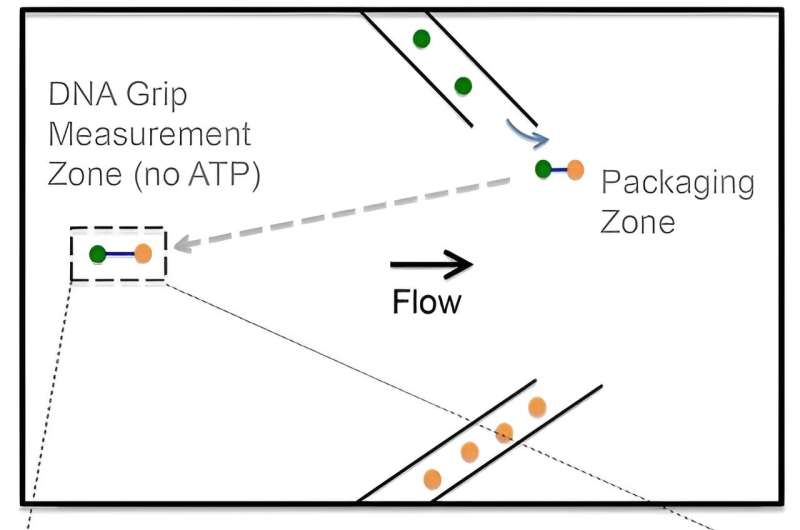This article has been reviewed according to Science X's editorial process and policies. Editors have highlighted the following attributes while ensuring the content's credibility:
fact-checked
peer-reviewed publication
trusted source
proofread
Laser-powered 'tweezers' reveal universal mechanism viruses use to package up DNA

Researchers have used laser-powered 'optical tweezers' to reveal a universal motor mechanism used by viruses for packaging their DNA into infectious particles.
The research, published as a Reviewed Preprint in eLife, is described by the editors as a fundamental study that could be paradigm-shifting for our understanding of how viral DNA motors work and the precise roles of individual proteins in the motor complex. They add that the experiments provide compelling evidence for the study's conclusions.
Many viruses, including those such as herpesvirus that affect humans, use tiny motors powered by a molecule called ATP to package their genetic material into pre-assembled shells called procapsids. Understanding how these motors work is not only important for the design of antiviral drugs but also sheds light on general motor mechanisms that apply to other types of motors within cells.
Optical tweezers are a method in which lasers are used to hold and move sub-microscopic particles. They were first developed by Arthur Ashkin, who later won the Nobel Prize in Physics for the innovation in 2018. These tweezers have allowed for more detailed studies of DNA motors, including the role of key component enzymes called terminases. However, much remains to be understood about the nature of motor-DNA interactions—such as how the motors grip DNA and what causes the motor to pause or slip.
"Studies have suggested that ATP binding causes DNA motors to grip hold of DNA, and the breakdown of ATP into ADP allows its release," says first author Brandon Rawson, a student in the Department of Physics at the University of California San Diego, U.S.
"To probe this interaction in more detail, we previously developed a modified optical tweezer method to study the motor of a bacterial virus called phage T4, which contains a motor protein called TerL, and showed that ATP not only triggers TerL to grip DNA but controls the friction between motor and DNA during slipping, too. In this study, we extended this to look at a motor complex containing TerL plus a lesser-understood component protein TerS to understand how they work together to control viral genome packaging."
The team studied the genome packaging motor containing both TerL and TerS from a bacterial virus called phage lambda, which uses a similar packaging process as the human herpesvirus. When these viruses replicate, they produce multiple linked copies of their genome, which then need to be snipped apart and each genome packaged separately.
One way that viruses do this is called 'unit length' genome packaging. In brief, the TerS subunit initiates packaging when it encounters a specific site called cos in the genome. TerL then cuts the genome and drives the packaging (DNA translocation) into the procapsid shell until another cos site is encountered. At this point, the motor stops, and TerL cuts the DNA to release the packaged particle. Although the role of TerL is known in the translocation and termination stage, whether TerS played a role during translocation was less clear.
By studying both TerL and TerS as functioning motors in the same experiment, the team noticed that in the presence of both TerS and TerL, there was much more frequent DNA gripping and high motor-DNA friction even when there was no ATP available. This has not been observed in previous experiments when only TerL is present.
When ATP or ADP were added, this further increased gripping and friction, indicating two mechanisms of motor-DNA interaction—nucleotide-dependent and nucleotide-independent. DNA gripping was strongest when ATP was bound to the motor, weaker when ADP was attached, and weakest with no nucleotide bound at all.
In previous studies with phage T4, the team had also discovered a DNA 'end clamp' that prevents the whole DNA molecule from slipping backward out of the procapsid during packaging. In this study, they found that the lambda phage shares this mechanism. If the DNA slips to the extent that it completely falls out, it is caught by its end and prevented from detaching from the procapsid, even if no ATP is present.
"Our present studies, building on studies of viruses that use different packaging mechanisms, reveal universal features of the terminase motors and suggest a role for the conserved TerS subunit during DNA packaging," says senior author Douglas Smith, UC San Diego Professor of Physics.
"These findings support a conserved universal mechanism for terminase motor function, conveyed by the TerL protein, but also highlight a key difference between systems—a much more frequent DNA grip in motors containing TerS, which suggests TerS functions as a sliding clamp. The separate end-clamp mechanism also increases the efficiency of packaging and is likely equivalent to the complex formed at the initiation of packaging, implying that our method could provide an avenue to explore factors affecting the stability of this complex."
More information: Brandon Rawson et al, Regulation of phage lambda packaging motor-DNA interactions: Nucleotide independent and dependent gripping and friction, eLife (2023). DOI: 10.7554/eLife.91647.1
Journal information: eLife
Provided by eLife




















